Kai 'Opua's Beginnings
Some early and incomplete records indicate that Kai 'Opua Canoe Club was first organized in 1929. Twenty men and twelve women formed the nucleus of the club and practiced then, as we do now, in Kailua Bay. Under the leadership of Mr. Lin Child and Judge Arthur Stillman, Kai 'Opua entered its first regatta in 1932. The regatta was held in Napo'opo'o Bay, and, according to the newspaper accounts, Kai 'Opua paddled in Judge Stillman's Kaimana (Diamond), a canoe that reportedly weighed 600 pounds, and raced against Milolii, Honaunau and Hilo, reportedly the only three other canoe clubs on the island. Entered in the race were two four-man crews for the half-mile race, two six-man crews for the three-mile race and two wahine crews of six each for the one-mile race.
Uncle Keoni Mano, one of the club's original paddlers/founders was later quoted in West Hawaii Today as saying: "In those days, forty strokes was the most we could do. We used the old, long, Hawaiian stroke, and the boats were pretty heavy then." Keliipaiomoku "Red" Kanuha, another early paddler and long-time club member and advisor, remembered how Judge Stillman was "the first head coach, and he loaned the club his boat, the Kaimana, but, in the winter of 1935, fuel tanks exploded during a Standard Oil fire and the Kaimana went up in flames."
It, along with some other Kai 'Opua canoes of various types and construction, were kept on the point of land that is now filled and used by King Kamehameha's Kona Beach Hotel for its luau grounds. The Standard Oil Company fuel tanks, which were located on the nearby shoreline, had exploded and burned, and, in the process, burned and destroyed all of the club's canoes. Soon afterwards, Judge Stillman purchased the Kaimalino or "Smooth Water" and gave it to Kai 'Opua for racing.
Early Regatta History
It was in 1934, that Kai 'Opua won its first major state-wide regatta, held at Napo'opo'o Bay, winning over all the Big Island clubs as well as the O'ahu clubs that had come over for the race. John "Uncle Keone" Mano stroked his six-man crew to victory, and, through the years, he inspired Kai 'Opua Club members to strive for excellence and spiritual harmony. He was born Peter J. Kaniau, on October 6, 1911, in Kailua-Kona, and was adopted and renamed John Mano.
As a boy, he spent much of his time at Kailua Bay, and it was there, at the small beach on the South side of the seawall, that he met Manuia Manupau, personal canoe steersman for Prince Kuhio. Manupau reportedly was a stern and no-nonsence man, but he was also expert at canoe rigging, paddling and sailing, and John Mano was eager to learn. Manupau passed his skills on to Uncle Keoni, who reportedly was always able to rig an unfamiliar canoe on land, set in the water, and have it correctly balanced on the first try. Uncle Keoni paddled for Kai 'Opua until the outbreak of WWII in 1941, and during that time he worked with Kona's master canoe builder, James T. Yamasaki. Mr. Yamasaki constructed canoes for O'ahu canoe clubs as well as for Big Island Clubs, and Uncle Keoni absorbed Mr. Yamasakai's many skills and abilities.
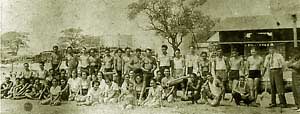
Kai 'Opua Canoe Club
American Factors Lumber Yard, Kamakahonu Bay - 1929
H. Ako, Pelekane, J. Wahinekapu, M. Kalele, A. Kamaka, M. Stone, I. Kunewa, Keawe, Yamasaki, Kahananui, Mano, R. Kanuha, Deguair, K. Spinney, Alice, Kamaka, W. Kaaialii, A. Spinney, H. Kunewa, Kaolelo, Lono, Hoomanawanui, J. Mano, Akamu, Kaikala Kainulama
With the commencement of WWII, Kai 'Opua Canoe Club ceased operation, and the Kaimalino was stored under Bill Upchurch's house. In 1946, Kai 'Opua was reformed, and the Kaimalino was retrieved for racing. However, it was in bad shape, so Mr. Yamasaki, Uncle Herbert Ako, Uncle Keoni and Uncle Red Kanuha took the canoe to the American Factors Lumber yard, and the four men took turns rebuilding it.
The Territorial Championships ("Julian R. Yates Canoe Championships"), sponsored by the Hawaiian Canoe Racing and Surfing Association, were held in August of 1952, in Kailua Bay, Kona. The clubs racing that day were Healani, Honaunau Canoe Club, Hui Kailia, Hui Nalu, Kai 'Opua Canoe Club, Koolaupokoo Canoe Club, Maalaea Boat & Fishing Club, Outrigger Canoe Club and Waikiki Surf Club. The Race Program, prepared by Kai 'Opua Canoe Club, for the Championships states:
"Little is known and less recorded about single outrigger canoe racing before the year 1906, but it is generally conceded that the sport had its beginning during the time of King Kamehameha V, whose big ocean-going canoe is now on exhibition at the Bishop Museum. The next known patron of the sport was Prince Kuhio whose two canoes, the "Princess" and the famous "A", are still in commission today. Tall tales are told of the races held between 1906 and 1909 off O'ahu, when the rivalry between Kona and Honolulu was as keen as it is today,
and it may be said that modern outrigger canoe racing really began with that now famous series between the paddlers of Kona in the "A" and the stalwarts of Outrigger Canoe Club in "Hana Keoki".
"There followed a lull of almost 23 years during which canoe racing on an interisland or Territory wide scale virtually ceased to exist. It was only through the interest of the Outrigger Club and others that the sport was preserved in the surf off Waikiki during this period of inactivity. The story of the revival of racing in the thirties is told in the tribute to Julian R. Yates on another page of this booklet, but it is fitting to mention here the names of others like Lorrin P. Thurston, "Dad" Center, Lewis Macfarlane, L.C. Child, John Black, and Judge Arthur Stillman who gave of their time, money and effort that the sport might be perpetuated."
Kai 'Opua entered and raced the Kaimalino in six of the nine events, from Boys Under 13 at 1/4 mile through Senior Men at 3 miles. The coaches for Kai 'Opua were listed as: James T. Yamasaki, Herbert Ako, Clement Kanuha, and Johnny Mano. Dad Center coached Outrigger Canoe Club and Wally Froiseth coached Waikiki Surf Club. There are many Kai 'Opua family names listed as paddlers, including Ako, Bronco, De Mello, Gaspar, Hugo Van Platen, Jr., Kunewa, Kanuha, Thompson, Kane and others.
Let The Races Begin...
Kai 'Opua Canoe Club commenced its King Kamehameha Day Regattas in 1972, in Kailua Bay with 30 racing events, and entering were five Big Island Clubs: Kai 'Opua, Kawaihae, Ailani, Prince David Kawananakoa and Keaukaha. Kai 'Opua was successful in winning the regatta. Crews included 13 and under to Senior men/women. The event began at 8:00 a.m. with a prayer by Leon Sterling, Sr., followed by a chant given by Iolani Luahini. Robert F. Greenwell, President of Kai 'Opua Canoe Club, presented the medals and trophies.
The club also started the Queen Lili'uokalani Long Distance Races in 1971 as a warm-up to the Moloka'i Hoe race. Kai 'Opua invited clubs from throughout Hawai'i, from the mainland and the Pacific Rim countries. Louis Kahanamoku was the General Chairman and Mary Jane Kahanamoku acted as Race Secretary.
In August of 1999, Mary Jane was asked about the origins of the race, and she replied as follows:
"The Queen Lili'uokalani Long Distance Race really began in our kitchen. Louis and I were talking about outrigger canoe racing, and he said 'We really need a race to get us prepared for the Moloka'i Channel Race.' We talked about the course, the divisions and the general aspects of organization and prepared a proposal. Louis then spoke about this new race to the Kai 'Opua Board of Directors. The Board, composed of Uncle Robert Greenwell, Dr. Mar, John DeGuair, Walter Perreria, Dick Dennison, Uncle Dona Kualii and Uncle Red Kanuha, agreed to the proposal that Louis presented, and they were all a big help in getting the race started.
Louis proposed that we name the race after Queen Lili'uokalani, as Labor Day falls right after her birthday, and we could invite clubs from all of the islands and even internationally. This is how the race started, and, through the dedication of Kai 'Opua members, it has grown from these very humble beginnings to the largest outrigger canoe race in the world. Much credit should be given to Kealai and Joe Salinas for their hard work in making the race happen.
At first, the race was for men only. However, in 1973, we again met with the Kai 'Opua Board of Directors and asked for a race for women, also. With the help of Kealai and Virginia Redfern as officials, we produced a very successful race, which was attended by O'ahu, Kauai and Maui clubs.
While visiting Tahiti with Pierre Kimitete and his family, Louis and I were introduced to double-hull racing. We later persuaded the Kai 'Opua Board to add this colorful event to the Queen Lili'uokalani Race as a Sunday morning fun race. It is now, of course, both a fun race and a competitive event for both men and women.
Much credit must be given to the people who organized and conduced these races, including Mike Atwood and Manny Veincent, who have been Race Directors for so many years, and to Zachary, Junior and Jerome Kanuha for their many years of assistance.
Onipaa! Kai 'Opua, and good luck in all the years to come in the Queen Lili'uokalani Races. Mahalo to all the outrigger clubs and supporters who have joined with us, year after year, to make this great race a success for everyone."
The club raced the Kaimalino regularly until 1976, when Kai 'Opua received several logs from the Hualalai Ranch, and Uncle Keoni, Uncle Herbert Ako and Uncle Red Kanuha, with help and guidance from Mr. Yamasaki, built the Hualalai. Also, in 1976, a four-man Tahitian canoe building crew, led by Jacques Wong, came to Kona in order to construct the Mahoe, now on display at the King Kamehameha's Kona Beach Hotel, and the Maehaa, used for many years by Kai Ehitu Canoe Club.
Pursuant to an agreement among Kai 'Opua Canoe Club, the Tahitian government and Jacques Wong, one canoe would be owned by Kai 'Opua, one by the Mayor in Tahiti and two would go to Jacques Wong for his work. One of the Koa logs was large enough in diameter for two canoes to be made from it, and the Tahitians and Kai 'Opua decided that one of the two would go to Kai 'Opua and the other to Jacques Wong. They further decided that each would name their canoe "Twin" in their respective languages, hence Mahoe and Maehaa. The canoe that would be owned by the Mayor in Tahiti was named Iwalani, after Iwalani "Pocho" Youderian, and remains in Tahiti. The other canoe was named the Honoura and remains in Hawai'i.
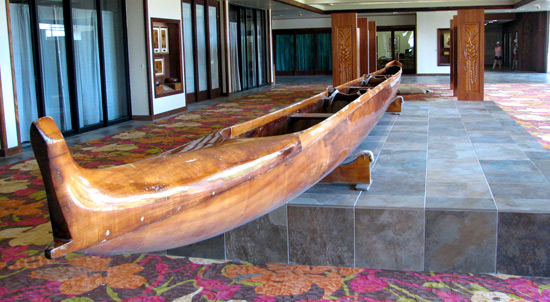
Mahoe, Kai Opua Canoe Club's 40-foot koa canoe, is displayed off the lobby of the King Kamehameha Hotel. "The canoe was retired, mostly because it was so dominant nobody could beat it",
Jak Hu (the general manager) said.
Photograph by Karin Stanton | Hawaii 24/7 Contributing Editor
In addition to the Kaimalino, the Mahoe and the Hualalai, the club also has the Kunane, Currently on display in the lobby of the Keauhou Beach Resort. The Kunane was constructed in 1985 by Uncle Keoni and Bill Rosehill, now President of Kona Athletic Club. Assisting and always present and offering encouragement and good conversation were Uncle Raymond Bronco and Uncle Red Kanuha. Because the four were very close friends, they decided to name the canoe the "Kunane", an affectionate term meaning brother, so to indicate that it had become another good friend.
The halau
After the Old Airport in Kona was shut down in 1970, when the Keahole airport, now Kona International Airport, opened, the State of Hawai'i in 1973
transferred 14 acres of the Old Airport grounds to the County of Hawai'i for park purposes, including the old passenger terminal, and later, in 1979, transferred an additional 19 acres to the County.
The old passenger terminal buildings were, in part, allocated to the Kona canoe clubs as their halau, and became known as the "canoe sheds". Because the sheds were inadequate in size, termite ridden and could not qualify for fire insurance, Kai 'Opua sought to obtain a more suitable location within the park, and Virginia Isbell, a club member and a member of the State Legislature, obtained legislation in 1993 transferring 5.423 acres of Old Airport land, still retained by the State, to the County of Hawai'i and an appropriation of $500,000 for the purpose of constructing initially two halau.
Site work and two concrete pads were constructed, but before further work could be accomplished, in 1996, the State sequestered the remaining funds, and the project languished until 2000. In that year, Kai 'Opua Canoe Club asked the County Council to sub-lease the acreage to Kai 'Opua in order that it might independently raise the necessary funds to complete the halau. The sub-lease was finally approved in 2002, and Kai 'Opua set about raising funds for halau construction. In 2009, the Office of Hawaiian Affairs, pursuant to a grant application prepared by a Kai 'Opua club member, granted the club $300,000 for the purpose of completing one halau. That halau was finished in January of 2011, and the club has begun moving its 23 canoes and equipment from the sheds to the new 6,000 square foot halau.
Training & Outrigger Canoe Racing
Kai 'Opua conducts training activities daily, usually mornings and evenings, during weekdays, March through September and we also have a recreational group of paddlers who paddle in the early mornings throughout the year. Regattas and long distance races are held on Saturdays and the club conducts at least four races each year in Kailua Bay: two commemorative regattas: the King Kamehameha Day Regatta and the Queen Lili'uokalani Long Distance Races, "Uncle Red Kanuha Day" race which is a family fun race and a Businessman's fun race for local businesses and government personnel.
In addition to these races, the club also participates in regattas and long distance races hosted by neighboring outrigger canoe clubs on the island as well as off-island long distance races, including the Na Wahine O Ke Kai, the Moloka'i Hoe and the Catalina Island to Newport Beach race. Paddlers in the regattas and long distance events are classified into age groups, 12 years of age and under through 60 years and over and race in these classifications.
Three Time World Champions Make History!
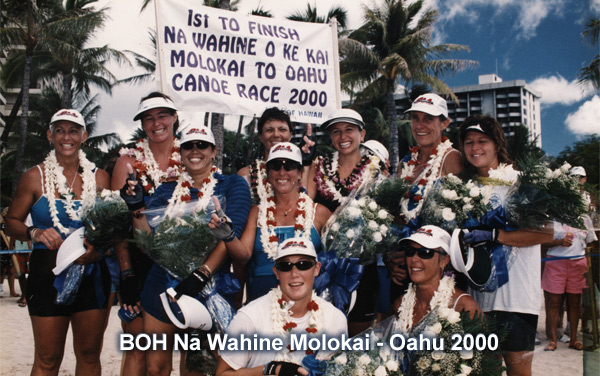
2000 Na Wahine o ke Kai winning crew
Kneeling; Jessica Eames, Patty Eames. Standing, left to right; Beth Cooper, Cheryl Villegas, Dondi Dawson, Nicky Lacey-Enos, Ronona Della Ciopa, Carrie Sue Hendricks, Amy Young and Jackie Taylor.
Towards the end of 1999, women's head coach Beanie Heen had built a strong Kai Opua women's crew, and then expanded its core group of women to represent the Big Island of Hawaii and successfully compete at the World Sprints in Townsville, Australia in the spring of 2000. That crew was the nucleus of what became a crew of women that went on to capture many titles in the name of Kai Opua Canoe Club.
This crew won the 2000 Na Wahine o ke Kai channel crossing in a relatively flat year. Although there was celebration, and the crew was given much support from Kai Opua and the ohana of the all Big Island, there was a strong drive amongst the closely bonded women to prove they could win in conditions that most paddlers would expect in the channel. Most of the next off-season was spent training in the rough waters at the north end of the island which borders on the Alenuihaha Channel, far from the mostly protected conditions of Kailua-Kona.
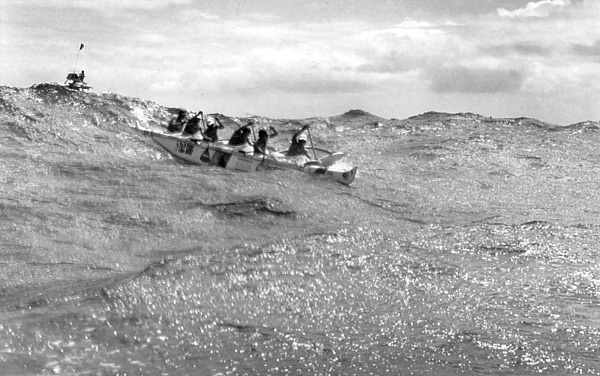
Photo Courtesy Wayne Levin
During the season of 2001, renowned ocean photographer Wayne Levin, documented many training and race sessions with this crew. He was with them on their winning 2001 Na Wahine o ke Kai crossing, the roughest Na Wahine channel crossing in recent memory. This was extreme gratification for a crew that normally trains in the protected waters of Kailua-Kona, enough that they felt their efforts satisfied themselves and their coach. But coach Beanie Heen envisioned more - winning three years in a row would prove how strong this "club crew" really was to the paddling world.
Not necessarily reluctant, but wondering how they could hold up under the pressure, the crew trained hard again and was victorious in 2002. A 3-peat from a club crew should be enough, that's for sure. Satisfaction for all, but after this win, some of the crew was moving onto other well deserved life pursuits.
The crew members remaining, Beth Cooper, Ronona Della Cioppa, Patty Eames, Nicki Enos, Cheryl Villegas and Amy Young went a bit under the radar to avoid the pressure and showed up to give Kai Opua a first over all win at Queen Lili'uokalani for the forth year in a row in 2003.
Looking forward to tackling Na Wahine a different way, these six women, along with another long-time Kai Opua member Jymi Friday, joined with paddlers from Kailua Canoe Club (Oahu, formerly coached by Beanie Heen). They formed a masters crew that would connect these paddlers together to honor each other, but mostly Coach Heen. The result at Na Wahine o ke Kai in 2003 was first place Masters, third overall... the highest placing ever for a Masters crew overall.
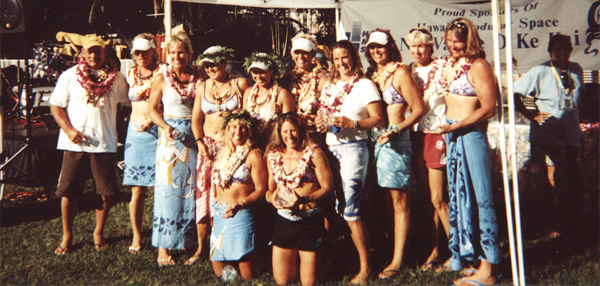
Coach Beanie Heen with his crew members from Kai Opua and Kailua Canoe Clubs
Patty Eames, Amy Young, Vivian Griffin, Carlenn Ornellas, Beth Cooper, Cindy Razga, Nicki Lacey-Enous and Cheryl Villegas. Kneeling; Ronona Della Cioppa and Torrey Goodman. Not Pictured; Jymi Friday.
During the years this women's crew dominated, the Kai Opua men went paddle to paddle with the tough competition in the men's Molokai Hoe. In 2000, Kai Opua men's open crew placed 3rd overall, a strong statement in this fiercely contested channel crossing.
Also Three TIme World Champions!
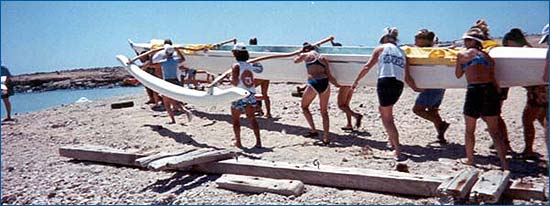
Mary Jo By, Nancy Concepcion, Jeanne Knapp, Susan Lalanne, Sari Lassiter, Denise Murphy, Debbie Noland, Linda Lee O'Dell,
Susan O'Shaughnessy, Miri Sumida, Kim Welty and Pocho Youderian
The Kai Opua Senior Masters crew (45 years and older) also won in its division and became a three-time consecutive winner at Na Wahine o ke Kai, winning in 6 hours 36 minutes and 32 seconds. Like the Open Crew, our Senior Masters are also the most successful crew in Big Island History. Cap Allen coached the crew.
The 40.8-mile race from Hale O Lono Harbor on the Island of Moloka'i, across the Kaiwi Channel to Duke Kahanamoku Beach at Waikiki on the Island of Oahu is regarded as the Women's World Championship of long distance outrigger canoe racing.
Kai 'Opua Canoe Club - Today
Today the club boasts membership of over 300 and have captured many championships over the years in Hawaii and beyond. We continue to grow and support the many traditions that have been laid before us.
|


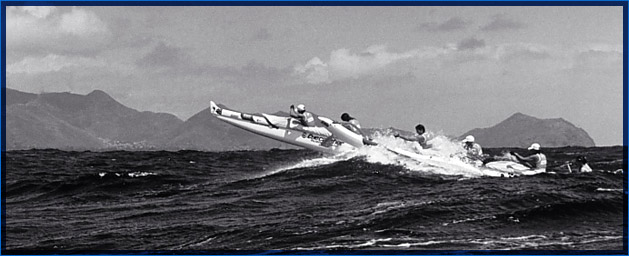







 DONATIONS
DONATIONS